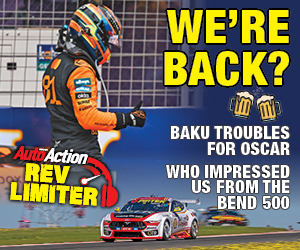SUPERCARS KNOCKOUT TRIAL LIKELY TO BE EXTENDED


Supercars three-phase qualifying system could be extended to more events – Photo: Rhys Vandersyde
SUPERCARS’ SUCCESSFUL trial of three-phase qualifying at Symmons Plains and Barbagallo may be extended to one more SuperSprint event this season.
By MARK FOGARTY
Despite widespread acclaim, the revived F1-style knockout format is unlikely to be adopted on a regular basis until next year.
The Supercars Commission will decide the future of the popular three-stage qualifying for SuperSprints at the rule-making group’s next scheduled meeting in June.
The new format, which also makes Friday practice more meaningful and representative, has been universally acclaimed by fans, broadcast commentators, drivers and team bosses.
There has been a consensus that the elimination aspect enlivens the qualifying action and increases the drama by mixing up the grid order, as evidenced by the shock failure of Scott McLaughlin, Mark Winterbottom and Craig Lowndes to make it past Q1 at Barbagallo.
Following a positive review by Supercars sporting staff, a recommendation to look at making the three-phase format standard for SuperSprint events in 2019 will be given to the Commission.
An additional trial later this season will also be suggested.
There will be no change to the gazetted qualifying formats before the Commission meets next month, meaning the July 20-22 Ipswich SuperSprint is the earliest likely candidate.
The Sydney SuperNight 300 is also a possibility because the night-racing event will utilise Sydney Motorsport Park’s shortest 2.8 km Druitt Circuit layout.
The three-stage elimination qualifying format – a variation of the knockout system used by Supercars from 2007-09 – was adopted this year for the recent rounds at the 2.4 km Symmons Plains Raceway, near Launceston in Tasmania, and the 2.42 km Barbagallo Raceway in Perth, Western Australia, to avoid the track congestion that occurred with the conventional all-in grid position deciders.
Symmons and Barbagallo are the shortest tracks on the schedule, with lap times under a minute.
Supercars technical and sporting director David Stuart confirmed that consideration would be given to adopting the three-phase format on a more regular basis in the future.
“It was a toe-in-the-water exercise for Symmons Plains and Barbagallo,” Stuart told Auto Action. “It does seem to have good appeal with the fans and the television audience, so it will definitely be a topic of discussion moving forward.
“Like anything, you can overdo it – you can over-expose it – but I think it is a good variance to what we have. It’ll be discussed at the Commission, which has to approve that it’s implemented at a round.
“We’ve pretty much set the formats for this year and, obviously, this qualifying format was set last year for Symmons Plains and Barbagallo. I don’t see this being rushed into the rest of the year. Let’s do things properly.
“The evaluation out of Tasmania was that it was a positive. It’s been backed up (at Barbagallo) again. It might be implemented for one more event further down the track this year, but other than that, my understanding is that the qualifying formats as set for the remainder of the SuperSprints will stay.
“If it is to become the regular format, it would be in 2019.”
At the very least, the three-stage qualifying format will be retained next year at Symmons and Barbagallo – subject to a renewal of the Perth SuperSprint.
“One would expect that that would be the case,” Stuart said.
The only mild criticism of the knockout system, which begins with the quickest 10 in Friday practice advancing straight to Q2, has been that the allocation of an extra set of tyres would enhance the procedure.
While Stuart agreed that four more tyres would improve the spectacle, he acknowledged that the extra $1000 per car would be a consideration.
“Again, my own personal view on this is that an extra set of tyres would make it even better,” he said. “But I don’t spend the money on tyres – and that’s something that we will present to the Commission to consider.
“Obviously, part of the Commission’s role is looking at the way we go racing and cost containment, but you have to balance that out with putting on the best show.”
For more of the latest Supercars news, pick up the latest issue of Auto Action, on sale now. Also make sure you follow us on social media Facebook, Twitter, Instagram or our weekly email newsletter for all the latest updates between issues.






